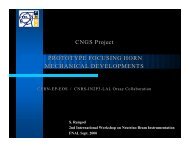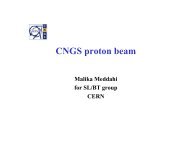New analysis techniques to reduce systematics due ... - CNGS - CERN
New analysis techniques to reduce systematics due ... - CNGS - CERN
New analysis techniques to reduce systematics due ... - CNGS - CERN
You also want an ePaper? Increase the reach of your titles
YUMPU automatically turns print PDFs into web optimized ePapers that Google loves.
Analysis <strong>techniques</strong> <strong>to</strong> <strong>reduce</strong> <strong>systematics</strong><br />
<strong>due</strong> <strong>to</strong> Hadron production<br />
(and other beam related issues)<br />
Micha̷l SZLEPER<br />
Northwestern University<br />
1. How best <strong>to</strong> use information from the near detec<strong>to</strong>r.<br />
a. Standard approach for an on-axis experiment.<br />
b. Improved approach and its generalization <strong>to</strong> off-axis.<br />
2. Prediction of the non-oscillated far detec<strong>to</strong>r spectrum.<br />
3. Evaluation of the ν e component of the beam.<br />
NBI 2002 <strong>CERN</strong> March 14-18, 2002
Standard approach with near detec<strong>to</strong>r I<br />
How <strong>to</strong> predict accurately the non-oscillated ν µ spectrum<br />
at a far detec<strong>to</strong>r?<br />
• Present knowledge - direct predictions from various hadron production models<br />
differ by up ro ∼ 25%.<br />
• Standard method: predict far detec<strong>to</strong>r spectrum based on spectrum measured in<br />
a near detec<strong>to</strong>r - “double ratio” method:<br />
dN Far<br />
dE<br />
[ dNFar<br />
]<br />
= dE<br />
dN Near<br />
dE nominal<br />
× dN Near<br />
dE<br />
• Nominal Far/Near ratio determined primarily by beamline geometry.<br />
• Non-oscillated far detec<strong>to</strong>r spectrum predictible within a few per cent.<br />
NNN Micha̷l SZLEPER Analysis <strong>techniques</strong> <strong>to</strong> <strong>reduce</strong> <strong>systematics</strong>... 2
Standard approach with near detec<strong>to</strong>r II<br />
“Double ratio” method applicable whenever the following is true:<br />
Each neutrino observed in the near detec<strong>to</strong>r ≡ expected certain flux of neutrinos in<br />
the far detec<strong>to</strong>r, with E Far = E Near .<br />
i.e., when secondary pion beam sees both detec<strong>to</strong>r at the same angle, Θ Far =Θ Near .<br />
BUT:<br />
• What about a realistic beam treatment (beam with imperfect pion focusing)?<br />
Θ Far ≠Θ Near<br />
• What about an off-axis experiment?<br />
Θ Far ≠Θ Near<br />
“Double ratio” method breaks down, more general approach required.<br />
NNN Micha̷l SZLEPER Analysis <strong>techniques</strong> <strong>to</strong> <strong>reduce</strong> <strong>systematics</strong>... 3
Standard approach with near detec<strong>to</strong>r III<br />
Low energy beam<br />
Medium energy beam<br />
ν µ<br />
CC<br />
5000<br />
4000<br />
x 10 4 0 2 4 6 8 10 12 14<br />
GFLUKA<br />
MARS<br />
ν µ<br />
CC<br />
7000<br />
6000<br />
5000<br />
x 10 4 0 2 4 6 8 10 12 14<br />
GFLUKA<br />
BMPT<br />
MARS<br />
Malensek<br />
3000<br />
BMPT<br />
Malensek<br />
4000<br />
2000<br />
3000<br />
1000<br />
2000<br />
1000<br />
0<br />
0<br />
Near<br />
E ν<br />
GeV<br />
Near<br />
E ν<br />
GeV<br />
ν µ<br />
CC<br />
1.25<br />
1.2<br />
1.15<br />
1.1<br />
1.05<br />
1<br />
0.95<br />
0.9<br />
0.85<br />
0.8<br />
0.75<br />
0 2 4 6 8 10 12 14<br />
(F/N) / (F/N) nominal<br />
E ν<br />
GeV<br />
ν µ<br />
CC<br />
1.25<br />
1.2<br />
1.15<br />
1.1<br />
1.05<br />
1<br />
0.95<br />
0.9<br />
0.85<br />
0.8<br />
0.75<br />
0 2 4 6 8 10 12 14<br />
(F/N) / (F/N) nominal<br />
E ν<br />
GeV<br />
NNN Micha̷l SZLEPER Analysis <strong>techniques</strong> <strong>to</strong> <strong>reduce</strong> <strong>systematics</strong>... 4
Improved approach I<br />
On-axis experiment with imperfect focusing:<br />
• An improved prediction of the far detec<strong>to</strong>r spectrum requires exactly the same<br />
approach as in off-axis, allowing E Far ≠ E Near in the general case.<br />
+<br />
π<br />
ν<br />
µ<br />
Θ<br />
1N<br />
Θ<br />
1F<br />
Near<br />
Far<br />
Horns<br />
+<br />
π<br />
Decay pipe<br />
Θ<br />
2N<br />
Θ<br />
2F<br />
ν<br />
µ<br />
The difference Θ N − Θ F increases with z.<br />
NNN Micha̷l SZLEPER Analysis <strong>techniques</strong> <strong>to</strong> <strong>reduce</strong> <strong>systematics</strong>... 5
Improved approach II<br />
What we want:<br />
Predict far detec<strong>to</strong>r spectrum for a realistic beam and an arbitrary location of the<br />
detec<strong>to</strong>r with accuracy comparable <strong>to</strong> the on-axis perfect focusing case<br />
• The same parent pion beam implies always a strong correlation between ν spectra<br />
in the on-axis near detec<strong>to</strong>r and an arbitrary (including off-axis) far detec<strong>to</strong>r.<br />
• Different angle implies different neutrino energy:<br />
E ν = 0.43 E π<br />
1+γ 2 θ 2 → E Far ≠ E Near .<br />
• Each neutrino observed in the near detec<strong>to</strong>r ≡ expected certain flux of neutrinos<br />
in the far detec<strong>to</strong>r, with P (E Far ,E Near ) ≠ δ(E Near ):<br />
dN Far<br />
dE Far<br />
= ∫ P (E Far ,E Near ) dN Near<br />
dE Near<br />
dE Near .<br />
• P (E Far ,E Near ) determined primarily by beamline geometry (and location of the far<br />
detec<strong>to</strong>r).<br />
NNN Micha̷l SZLEPER Analysis <strong>techniques</strong> <strong>to</strong> <strong>reduce</strong> <strong>systematics</strong>... 6
Improved approach III<br />
How <strong>to</strong> get P (E Far ,E Near )<br />
• Every decaying pion is assigned <strong>to</strong> weights: w Near/F ar = w Near/F ar (E π , Θ π ,z,r),<br />
defined as the fraction of all decays with a neutrino ending up in the near/far<br />
detec<strong>to</strong>r.<br />
• Neutrino energies E Near/F ar are unambiguously given by E π , Θ π ,z,r.<br />
• For a point-like pion source, every neutrino with E Near implies w Far /w Near neutrinos<br />
with E Far .<br />
• For a non-trivial, known, pion decay distribution Φ π (E π , Θ π ,z,r):<br />
P (E Far ,E Near )=<br />
∫∫∫∫<br />
∫∫∫∫<br />
Φπ w Far dE π dΘ π dz dr<br />
Φπ w Near dE π dΘ π dz dr<br />
with integration over all phase space yielding E Near and E Far in the numera<strong>to</strong>r, and<br />
E Near in the denomina<strong>to</strong>r.<br />
NNN Micha̷l SZLEPER Analysis <strong>techniques</strong> <strong>to</strong> <strong>reduce</strong> <strong>systematics</strong>... 7
Improved approach IV<br />
• Far spectrum prediction in finite energy bins:<br />
P (E Far ,E Near ) → M(N bins × N bins ).<br />
→ →<br />
N Far = M · N Near<br />
M - Near-<strong>to</strong>-far correlation matrix, in general non-diagonal.<br />
Toy example with 2 energy bins<br />
[ ][ ]<br />
( )<br />
N<br />
Far<br />
1 ,N2<br />
Far M11 M = 12 N<br />
Near<br />
1<br />
M 21 M 22 N Near<br />
2<br />
(1)<br />
• On-axis, perfect focusing: M 12 ,M 21 =0.<br />
• Realistic on-axis: M 21 > 0.<br />
• Off-axis: M 12 >> 0,M 21 ,M 22 ≈ 0.<br />
NNN Micha̷l SZLEPER Analysis <strong>techniques</strong> <strong>to</strong> <strong>reduce</strong> <strong>systematics</strong>... 8
On-axis experiment - hadron production<br />
Realistic on-axis experiment<br />
Low energy beam<br />
Medium energy beam<br />
NNN Micha̷l SZLEPER Analysis <strong>techniques</strong> <strong>to</strong> <strong>reduce</strong> <strong>systematics</strong>... 9
On-axis experiment - other beam related issues<br />
Upper plots: M matrix, lower plots: double ratio<br />
Beam simulation (PBEAM spectrum)<br />
Horn 1 shifted by 2 mm<br />
1.2<br />
1.25<br />
1.15<br />
1.1<br />
1.05<br />
1.2<br />
1.15<br />
1.1<br />
1.05<br />
1<br />
1<br />
0.95<br />
0.9<br />
0.85<br />
0.95<br />
0.9<br />
0.85<br />
0.8<br />
0.8<br />
0 1 2 3 4 5 6 7 8 9 10<br />
0.75<br />
0 1 2 3 4 5 6 7 8 9 10<br />
1.2<br />
1.25<br />
1.15<br />
1.1<br />
1.05<br />
1.2<br />
1.15<br />
1.1<br />
1.05<br />
1<br />
1<br />
0.95<br />
0.9<br />
0.85<br />
0.95<br />
0.9<br />
0.85<br />
0.8<br />
0.8<br />
0 1 2 3 4 5 6 7 8 9 10<br />
0.75<br />
0 1 2 3 4 5 6 7 8 9 10<br />
NNN Micha̷l SZLEPER Analysis <strong>techniques</strong> <strong>to</strong> <strong>reduce</strong> <strong>systematics</strong>... 10
Off-axis experiment - hadron production<br />
Low energy option<br />
Predictions for far detec<strong>to</strong>r spectra<br />
(NuMI beamline, LE, L = 735<br />
km), D = 10 km off axis.<br />
• On absence of any near detec<strong>to</strong>r:<br />
∼25% uncertainty.<br />
• With an on-axis near detec<strong>to</strong>r<br />
(M matrixderived from each<br />
model):<br />
GFLUKA: 74.2 events 1-3 GeV,<br />
BMPT: 74.3 events,<br />
MARS: 74.7 events,<br />
Malensek: 75.4 events.<br />
NNN Micha̷l SZLEPER Analysis <strong>techniques</strong> <strong>to</strong> <strong>reduce</strong> <strong>systematics</strong>... 11
Off-axis experiment - hadron production<br />
Medium energy option<br />
Predictions for far detec<strong>to</strong>r spectra<br />
(NuMI beamline, ME, L = 735<br />
km), D = 10 km off axis.<br />
• On absence of any near detec<strong>to</strong>r:<br />
∼40% uncertainty.<br />
• With an on-axis near detec<strong>to</strong>r<br />
(M matrixderived from each<br />
model):<br />
GFLUKA: 81.9 events 1-3 GeV,<br />
BMPT: 82.4 events,<br />
MARS: 82.6 events,<br />
Malensek: 82.6 events.<br />
NNN Micha̷l SZLEPER Analysis <strong>techniques</strong> <strong>to</strong> <strong>reduce</strong> <strong>systematics</strong>... 12
Off-axis experiment - focusing system<br />
HORN 1 DISPLACED BY 2 MM<br />
Presence of an onaxis<br />
near detec<strong>to</strong>r assumed.<br />
Prediction: Undis<strong>to</strong>rted<br />
M matrix<br />
applied <strong>to</strong> the dis<strong>to</strong>rted<br />
near detec<strong>to</strong>r<br />
spectrum.<br />
Total expected ν µ CC<br />
rate for 1
Off-axis experiment - ν e background<br />
INTRINSIC ν e<br />
, FAR 10 km OFF AXIS<br />
Hadron production related<br />
uncertainties are<br />
minimized by using ν µ<br />
information from the<br />
on-axis near detec<strong>to</strong>r.<br />
E.g., for 1






